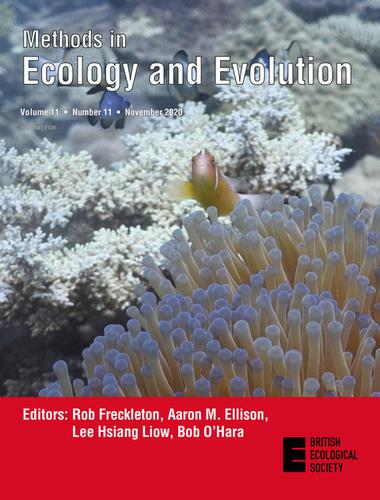当前位置:
X-MOL 学术
›
Methods Ecol. Evol.
›
论文详情
Our official English website, www.x-mol.net, welcomes your
feedback! (Note: you will need to create a separate account there.)
Cover Picture and Issue Information
Methods in Ecology and Evolution ( IF 6.3 ) Pub Date : 2020-11-02 , DOI: 10.1111/2041-210x.13228
Methods in Ecology and Evolution ( IF 6.3 ) Pub Date : 2020-11-02 , DOI: 10.1111/2041-210x.13228

|
Cover image: This month's cover image shows some of the marine life that inhabits the Great Sea Reef of Fiji. Coral reefs provide important habitat for demersal fish such as the damselfish and anemonefish pictured, with the complex 3D structure of the corals offering them refuge from larger predators. The diverse array of organisms that make up a reef's structure are also highly dynamic; growing, eroding, shifting, settling, or disappearing over time. In recent years, underwater camera‐imaging technology has allowed us to virtually recreate the shape and texture of underwater objects by stitching together many overlapping images. This now allows us to quantitatively analyse physical structures, or construct large‐scale photo‐mosaic maps of the seafloor to view change. In this issue, Bayley & Mogg present a user‐friendly protocol for creating, analysing and visualising large‐scale 3D digital models of reefs using ‘Structure from Motion’ photogrammetry. Their guide is aimed at helping researchers to apply, standardise, and widen the use of this emerging and rapidly developing technology for marine conservation and management.
中文翻译:

封面图片和发行信息
封面图像:本月的封面图像显示了居住在斐济大礁石上的一些海洋生物。珊瑚礁为深海鱼类(如照片中的雀鲷和海葵鱼)提供了重要的栖息地,珊瑚的复杂3D结构为它们提供了逃避大型捕食者的庇护所。组成礁石结构的各种生物体也是高度动态的。随着时间的流逝而增长,腐蚀,移动,沉淀或消失。近年来,水下相机成像技术使我们能够通过将许多重叠的图像拼接在一起来虚拟地再现水下物体的形状和纹理。现在,这使我们能够定量分析物理结构,或构造海底的大型光影图,以查看变化。在本期中,Bayley&Mogg提出了一种用户友好的协议,该协议使用“运动构造”摄影测量法创建,分析和可视化珊瑚礁的大规模3D数字模型。他们的指南旨在帮助研究人员为海洋保护和管理应用,标准化和扩展这种新兴且快速发展的技术。
更新日期:2020-11-03
中文翻译:

封面图片和发行信息
封面图像:本月的封面图像显示了居住在斐济大礁石上的一些海洋生物。珊瑚礁为深海鱼类(如照片中的雀鲷和海葵鱼)提供了重要的栖息地,珊瑚的复杂3D结构为它们提供了逃避大型捕食者的庇护所。组成礁石结构的各种生物体也是高度动态的。随着时间的流逝而增长,腐蚀,移动,沉淀或消失。近年来,水下相机成像技术使我们能够通过将许多重叠的图像拼接在一起来虚拟地再现水下物体的形状和纹理。现在,这使我们能够定量分析物理结构,或构造海底的大型光影图,以查看变化。在本期中,Bayley&Mogg提出了一种用户友好的协议,该协议使用“运动构造”摄影测量法创建,分析和可视化珊瑚礁的大规模3D数字模型。他们的指南旨在帮助研究人员为海洋保护和管理应用,标准化和扩展这种新兴且快速发展的技术。











































 京公网安备 11010802027423号
京公网安备 11010802027423号